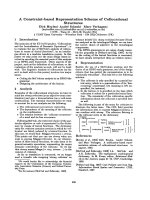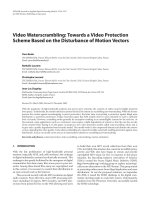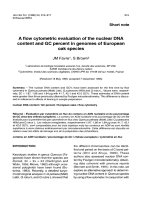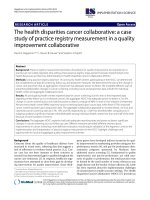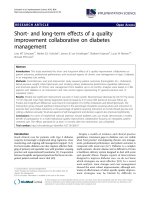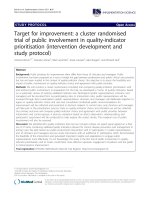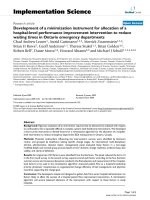A PERFORMANCE IMPROVEMENT SCHEME OF CONTENT CENTRIC NETWORKING OVER MULTI SOURCE CONTENT DISTRIBUTION
Bạn đang xem bản rút gọn của tài liệu. Xem và tải ngay bản đầy đủ của tài liệu tại đây (984.17 KB, 10 trang )
Tạp chí Khoa học và Cơng nghệ, Số 28, 2017
A PERFORMANCE IMPROVEMENT SCHEME OF CONTENT CENTRIC
NETWORKING OVER MULTI-SOURCE CONTENT DISTRIBUTION
ONG MAU DUNG, BUI THU CAO
Industrial University of Ho Chi Minh City;
,
Abstract. Nowadays, Content Centric Networking (CCN) becomes one of the important technologies for
enabling future network. In CCN, the contents are cached along the reverse path from the producer to the
consumer, and they may be reused for many times without fetched from the original producer. In such
kind of operation, the CCN improves network performance by reducing redundant transmissions of
popular contents. However, the volume of the content store (CS) located in the gateway/router is
constrained, and much smaller than the size of existing Internet contents which would go through the
gateway/router, when rich media applications are considered. In order to solve this issue, this paper
proposes a novel Multi-Source Content Centric Networking (MS-CCN) scheme by leveraging the concept
of Multi-Source Mobile Streaming (MS2). In the MS-CCN model, the caching of each content is not
limited in the single server anymore as in conventional CCN model, instead, each content is fragmented
and distributed to multiple servers over a large scale network. After experiencing disjoint multi-paths,
various content fragments are concatenated at client side. The OPNET Modeler simulation results show
that the MS-CCN scheme significantly outperforms the original CCN scheme in terms of network
utilization and user's Quality of Experiment (QoE).
Keywords. Content centric networking, caching, multi-streaming, network traffic offload.
1
INTRODUCTION
Recently, the global data traffic forecast from Cisco has unveiled two important trends relative with
mobile networking [1]. Firstly, the amount of global mobile data traffic increases exponentially from year
2014 to 2019. Secondly, mobile video traffic dominates Internet traffic by occupying 50% percentages of
whole traffic in 2012, then 55% percentages by the end of 2014, indicating that mobile video traffic
impacts on Internet traffic today. Usually, single-source single-path (SSSP) routing is used between end
user and server due to its simplicity. However, facing the sheer volume of rich video applications, the
traditional SSSP routing will cause the bandwidth of Internet backbone insufficient to keep up with the
Quality of Service (QoS) requirement for the huge number of mobile users.
Content Delivery Network (CDN) are capable to delivering better end-to-end performance than
original clients-server by deploying in widely a large number of Autonomous System (AS). CDN
includes some center servers and the number of edge servers placed in wide geographic locations. Using
CDN, the request content come from users will be redirected to the nearest edge server to solve the
backbone network bottleneck and provide better quality of service. However, with the exponential growth
of Internet traffic, especially video traffic, the CDN requires very high cost for large storage in the edge
servers. Besides CDN, cloud computing provides elastic infrastructure and pay-as-you-go. These
characteristics make cloud computing become a suitable solution for the drawback of CDN about large
storage [2].
In comparison, multi-source single-path (MSSP) proposed for the better utilization of the overall
possible Internet links. By splitting of data packets among different routing paths, the average packet drop
rate on each path is smaller in case of network congestion. In [3], a multi-source mobile streaming (MS2)
architecture is proposed to further alleviate the impact of network congestion on mobile streaming
services, by efficiently utilizing the available network resources through an effective rate allocation
scheme among multiple sources that collaborate to stream the same content in a complementary manner.
However, the total bits transferred between server side and end user side is not reduced for all above
situations, e.g. SSSP, MSSP, and MS2.
© 2017 Trường Đại học Cơng nghiệp thành phố Hồ Chí Minh
A PERFORMANCE IMPROVEMENT SCHEME OF CONTENT
CENTRIC NETWORKING OVER MULTI-SOURCE CONTENT DISTRIBUTION
79
Related with the exponential growth of traffic, a skewness of popularity content characteristic was
discussed in [4], that is to say, a few most popularity contents are often queried by the huge number of
end users. Therefore, it is critical to design an effective way to minimize the duplicate content deliveries
to save bandwidth and offloading server traffic. In order to alleviate the bandwidth problem and
concerned the skewness of popularity content, content centric networking (CCN) is proposed to
effectively distribute popular data content to a huge number of users [5]. To maximize the probability of
sharing with minimal upstream bandwidth demand and lowest downstream latency, routers/gateways
should keep all arrived contents as long as possible. Furthermore, reducing traffic load by in-network
caching can enhance the mobile network with higher energy efficiency and toward the evolution to the
“green” mobile network.
In this paper, following the MS 2 architecture and the background of the CCN, we integrate the MS2
mechanism to CDN and CCN architecture, dulled by Multi-Source CDN (MS-CDN) and Multi-Source
CCN (MS-CCN), respectively. Our OPNET Modeler simulation [6] results prove that the CCN is a good
revolution for existing challenges of traditional IP network. And with the same network configuration, the
MS-CCN outperforms than the original CCN and MS-CDN with lower round trip time, lower effect from
the Internet bottleneck links and offloading servers.
The remainder of this paper is structured as follows. Section 2 highlights some recently research
work pertaining to multi-path, multi-source streaming techniques, and overview the MS2 model operation.
Section 3 describes the MS-CDN, MS-CCN network architectures and evaluates the precision of the
simulation. Section 4 further presents the MS-CCN improvement based on the network model from
Section 3. Finally, the paper concludes in Section 5.
2
RELATED WORK
2.1 CCN overview
Streaming services from nearby nodes or routers goes back to a decade or longer [7]. Content Centric
Networking came to play to organize such an efficient streaming based on smart caching of popular
content nearby the requesting users. The CCN model presents a simple but effective communication. In
CCN, two types of packets are envisioned to identify a content, which is typical hierarchical and human
readable. They are namely interest packet (IntPk) and data packet (DataPk). CCN nodes maintain three
data structures: Forwarding Information Base (FIB), Pending Interest Table (PIT) and Content Store (CS).
Once a CCN node receives an IntPk, it looks up its CS. If an appropriate content is found as known as
hitting content, some DataPks will be sent for a request, otherwise the IntPk will be checked in PIT. PIT
keeps track of unsatisfied IntPks. After PIT creates a new entry for an unsatisfied IntPk, the IntPk is
forwarded to upstream towards a potential content source based on FIB's information.
A returned DataPk will be sent to downstream and stored on CS. In general, a content is cached at
routers for a certain time. When the “caching” deadline expires, the content is removed to cope with the
limited size of content storage. When CS is about to get full or receive a new content, it stores the new
content according to the underlying replacement policy to leave space for the new content. Least Recently
Used (LRU), Least Frequently Used (LFU) and First In First Out (FIFO) are few notable examples of
replacement policies for CCN.
2.2 Multi-streaming
For the actual delivery of streaming services, a wide library of research works has been conducted.
Many research works have considered the delivery of multimedia on multiple routing paths [8, 9, 10].
The concept of multi-path routing has been also investigated in the context of CCN. In [11], some
disadvantages attributed to the original CCN routing scheme are highlighted. That is, the best-face routing
(BFR) mechanism is used to find the highest suitable routing path for the IntPk uplink routing and the
DataPk download. Because others possible faces are unused, the BFR mechanism is become unbalance
load and the load of the best face with its repository is easy overloaded. To overcome with this limitation,
the multi-path routing scheme is proposed, whereby different repositories are enable to retrieve from
different chunks of one content simultaneously.
© 2017 Trường Đại học Cơng nghiệp thành phố Hồ Chí Minh
80
A PERFORMANCE IMPROVEMENT SCHEME OF CONTENT
CENTRIC NETWORKING OVER MULTI-SOURCE CONTENT DISTRIBUTION
Similarly, in [12], the potential of multi-path communications in CCN is explored. In order to
compare performance between multi-path and single-path schemes, some important metrics are used such
as: round trip time (RTT), throughput and download time. The original Round Robin distribution
mechanism is used to split the traffic strategy. Moreover, the skewness popularity of content, e.g. Zipf
based popularity model, is discussed with adopting replacement policies such as LRU, FIFO, and random
replacement.
2.3 A basic MS2 model
The example MS2 architecture and its supporting mechanisms can be found in details in [3]. Figure 1
presents the considered MS2 model topology, which involves three media servers servicing a number of
user equipment (UE) via a single access point (AP). The example network includes three uncorrelated
paths from the servers to the UE side. A Domain Manager or a Decision Maker (DM) in the MS2
architecture handles the overall service management.
Figure 1. Simplify MS 2 model with three servers.
As detailed in [3], MS2 operates following a number of states. In the initial state, the DM sends a
request information packet to its management Server[i] with i=1,2,3 in this example network; and
receives some of reply information packets from the Server[i]. A path delay (Di) from Server[i] to the
DM is calculated by the DM and then, available bandwidth (BWi) of the bottleneck link between the DM
and the Server[i] is estimated by the information packet size over the path delay. It should be noted that
DM usually updates BWi because of fluctuate network traffic. Following the MS2 paper, after having BWi
v
from appropriate servers, the DM continues to calculate: streaming rate (Ri), number of packets ( Pi ) to
be sent during the monitoring period ( ), data packet inter-transmission times ( i ), and the time to
commence the transmission ( i ). Finally, two parameters Ri and i are informed to the Server[i], and the
Server[i] also continues to calculate Pi and i .
In the working state, the UE sends the IntPk to request content to the DM. The DM bases on the path
delay Di, make an appropriate delay to forward the IntPk to all servers nearly at the same time. All servers
v
bases on i , i and Pi , make a packet scheduling to send DataPks to the UE. The servers schedule the
delivery of DataPks to the UE in a way that the packets of the same content are arriving in order at UE,
without high jitter, and most importantly without duplicate packets that could drain up the battery lifetime
of the UE [3].
v
© 2017 Trường Đại học Cơng nghiệp thành phố Hồ Chí Minh
A PERFORMANCE IMPROVEMENT SCHEME OF CONTENT
CENTRIC NETWORKING OVER MULTI-SOURCE CONTENT DISTRIBUTION
3
81
MULTI-SOURCE IN THE CONTEXT OF CDN AND CCN
Content delivery network (CDN) improves the QoS by replicating the most popular content on some
specific repositories, as close as possible to users. The content centric networking (CCN) is name-based
routing and caching content along the reverse path from server to clients. Both of CDN and CCN are
offloading network traffic, reducing end-to-end packet delay. However, not many works address on the
comparison between CDN and CCN.
The general CDN architecture includes four components: origin server, replica server, RequestRouting mechanism (Req-R) and client. Origin server is a content provider. Replica server maintains a
part of catalog contents from origin server. Req-R re-directs requests from clients to appropriate replica
server. If hitting content, contents are replied to clients by replica server. If missing content, requests from
UEs are continue to fetch to origin server. Push phase is a process to copy contents from origin server to
replica servers. The copied contents are selected as popular contents to enable maximize hitting rate at
replica servers. Pull phase is a process that contents are fetched from origin server (or replica servers) to
clients. In the context of MS2, Req-R is added into domain manager (DM) to enable the delivery of the
requests from MSs to replica servers.
3.1 Non-cooperative Push Phase
Let H denote hitting rate at replica server in the MS-CDN scheme. We assume that all replica servers
have the same capacity of storage including the same popular contents, dubbed “non-cooperative push
phase”. In this scheme, origin servers have knowledge about content popularity, enabling the most
popular contents to be chosen and transferred to all replica servers. We use Pareto distribution as popular
contents distribution with a probability distribution function (pdf):
f ( x) =
c.a c
x c +1
(1)
Where a denotes a scale parameter, c denotes a shape parameter, and x denotes content identification
with a constraint. Let Nf denote a number of the most popular contents can be located in replica servers,
and nvideo denote the catalog contents (the number of demand videos). Relative cache size is:
Rcache =
Nf
(2)
nvideo
Then, hitting rate is calculated as:
H=
a+N f
x=a
a+N
f
c.a c c
c
=
.
c +1
x
a x =a x
The number of request during simulation is:
nreq = nUE .
c +1
with N f nvideo
tstop − t start
llength
(3)
(4)
The number of demand video is:
nvideo = max{x − a +1} , subject to nreq . f ( x) 1, x a
(5)
3.2 Cooperative Push Phase
Having described the operation of MS2, CDN architectures and principle components. We now
present on how the MS2 can be integrated to CCN strategies, dubbed MS-CCN. In MS-CCN scheme,
when CCN nodes are found for the stream of a particular content, they operate as the same fashion of
servers in MS2 architecture. As shown in the Fig.2, because of uncorrelated reverse paths from servers to
DM, the particular content is fragmented and transmitted as “cooperative push phase” to CCN nodes.
Let Hi denote the hitting rate obtained on each path from servers to UE, ROffloading[i] denotes amount of
traffic offloaded on Path[i], the network non-congestion condition and bottleneck link utilization on each
path will be:
© 2017 Trường Đại học Cơng nghiệp thành phố Hồ Chí Minh
82
A PERFORMANCE IMPROVEMENT SCHEME OF CONTENT
CENTRIC NETWORKING OVER MULTI-SOURCE CONTENT DISTRIBUTION
Figure 2. MS-CCN network simulation with three server’s distribution.
ROffloading [ i ] = H i .(nUE .Ri ), i = 1, 2,..., nS
(6)
BWi (1 − H i ).(nUE .Ri ) + RVBR
(7)
U Link [i ]
BW
(1 − H i ).nUE . nS i .R p + RVBR
BWi
i =1
=
BWi
(8)
3.3 Network architecture
To evaluate the performance of MS-CDN and MS-CCN, we implemented CDN, CCN, MS2 and
conducted simulations using the OPNET Modeler 16.0. In the simulations, CCN is overlayed over the IP
layer. Indeed, we integrated the CCN processing modules into all network elements, such as router, UE,
server and DM. With every intention to consider a typical Internet network topology, we envision a
typical multi-source CCN model with three server’s distribution as shown in Fig.2 for the simulation.
There are eight UEs requesting different contents and every UE requires seamless video streaming with a
constant rate 800Kbps. UEs send randomly the request content around the 50th second after the start of the
simulation, e.g. 50+Uniform(0;10)s. Videos are streamed from video servers and finally received by CCN
processors located inside gateway/router. After executing underlying video caching/replacement policies,
CCN processors supply requesting UEs with requested video content when available at CCN nodes. In
this paper, we apply FIFO replacement policy to achieve the benefits of CCN.
In order to make different Quality of Experiment (QoE) between the single-source scheme and
multi-source scheme, we set up a bottleneck link between server side and client side. Because of the
bottleneck link, some of packets may be dropped and cannot reach UE during the network traffic
congestion time. UE maintains the time-out to resend the request for the packet loss. Moreover, in order
to simulate a realistic background traffic, variable bit rate (VBR) with different shapes of network traffic
is also considered between GW-1 and GW-2, generated by VBR-1 and VBR-2. The VBR is combined by
two shape of network traffic at the same time, e.g. Uniform(0.002;0.02)+Poisson(0.02)s, for intertransmission packets.
The packet size is fixed at 1KB. All VBRs are initiated at the 10th second after the start of the
simulation and maintained until the end of the simulation. For instance, we consider Pareto with a=104
and c=102 for both math model and simulation model. Hitting rates are compared to check consistency
between results. Starting from the simulation, there are 12 UEs sending request content at around 50s. The
simulation is terminated at 2000s. The length of video content is set to 2s to speed up simulation time.
© 2017 Trường Đại học Cơng nghiệp thành phố Hồ Chí Minh
A PERFORMANCE IMPROVEMENT SCHEME OF CONTENT
CENTRIC NETWORKING OVER MULTI-SOURCE CONTENT DISTRIBUTION
83
Figure 3. MS-CDN and MS-CCN with three server’s distribution.
In the MS-CDN scheme, six scenarios with Nf=30, 60, 90, 120, 150 and 180, respectively. Under the
same network configuration with the MS-CDN scheme, we set up five scenarios with Nf=15, 30, 45, 60,
and 75, respectively for the MS-CCN scheme. From the simulation results in Fig.3, we conclude some
important notes:
• Data points of hitting rate in the CDN OPNET simulation match with theoretical curve based on
CDN math model, which demonstrates the accuracy of our mathematical model and validating
our simulation setup.
• CCN approach always outperforms than CDN approach in the same network simulation.
Because of non-cooperative push phase, all of replica servers in CDN have the same contents. In
the CCN scheme, the content is distributed over several CCN nodes (located inside edge
routers/gateways) which help the CCN scheme can store more popular contents than CDN
scheme.
• However, the replica server of CDN is typical much greater than content store of CCN, then
CDN approach may has the same or higher performance than CCN approach. Thus, CDN
approach is trade-off cost of the replica server and performance.
4
MULTIPLE SCENARIOS FOR MS-CCN MODEL EVALUATION
Figure 4. A simplify MS-CCN network simulation with five server’s distribution.
© 2017 Trường Đại học Cơng nghiệp thành phố Hồ Chí Minh
84
A PERFORMANCE IMPROVEMENT SCHEME OF CONTENT
CENTRIC NETWORKING OVER MULTI-SOURCE CONTENT DISTRIBUTION
Table 1. Simulation Parameters.
Name
Packet types
UE
DM/Server
Bottleneck links
Other links
Contents
Content Store (CS)
Attribute
Information
Interest (IntPk)
Data (DataPk)
Buffer size
Play rate
Wireless interface
DataPk time-out
Start time
Stop time
Monitoring time interval
Single server
Two servers
Three servers
Four servers
Five servers
GW-GW
Other links
Video size
Popularity characteristic
Relative cache size
Replacement policy
Value
32 B
32 B
1 KB
100 Pks
100 Pk/s
802.11g @54 Mbps
0.6s
50 + Uniform(0;10)s
2000s
0.3s
6 Mbps
5; 6 Mbps
4; 5; 6 Mbps
4; 5; 6; 6 Mbps
4; 5; 6; 6; 6 Mbps
OC-24
1000Base-X
200 DataPk/ 2s
Pareto(10 4;102)
0.025; 0.05; 0.1; 0.15; 0.2
FIFO
Figure 4 depicts the considered MS-CCN model simulation topology, which includes five servers.
As shown in Fig.4, the topology consists of five uncorrelated paths from the servers to the gateway
traversing a number of routers/gateways. The simulation network includes two wireless domains. All UEs
within the radio range of AP-1 and AP-2 are managed by DM-1. Similarly, UEs, connected to AP-3 and
AP-4, are handled by DM-2.
In the envision network in Fig.4, caching contents are deployed at edge gateways for all simulation
schemes, e.g. GW-1; GW-3; GW-5; GW-7 and GW-9. Edge caching is of vital importance for the CCN
which becomes highly efficient with intelligent caching at edge routers/gateways. This efficiency
degrades as caching occurs far from end-users. By caching, some popular video contents are accessed
from nearby caches, bypassing bottleneck links. For this reason, the average data packet delays become
reduced. To evaluate a spreading of requirement bandwidth through multi-source and disjoint multi-path,
some assessment metrics such as: bottleneck link utilization, hitting rate, offloading servers traffic and
server responding delay are used in the simulation. Table I lists the rest of the simulation parameters.
Figure 5a compares the bandwidth (BW) utilization on the 6Mbps bottleneck link under variety
multi-source. In the typical single-source CCN scheme, the single-path link utilization often reaches its
maximum capacity, resulting in network congestion. By leverage the concept of MS2, the content delivery
is distributed among several servers, e.g. 2, 3, 4, and 5 servers, respectively, with disjoint routing paths to
UE. Thus, the minimum available BW requirement on routing paths are reduced quickly, associated with
the number of servers. For this reason, the MS-CCN model not only uses less bandwidth from the
bottleneck links but also improves the utilization free BW of the entire network.
Figure 5b compares among the CCN performance of different multi-source schemes when the
relative cache size is set to 0.1. In Fig. 5b, the obtain simulation results show that a better hitting rate can
be achieved when increasing the number of server’s distribution. When higher number of server’s
distribution is explored, resulting lower data packets are delivered on each routing path and unfrequently
replacements of data packets at caches. Under MS2 streaming flows, CSs from edge CCN nodes located
in disjoint multi-path are cooperative in popular content storage. Thus, the hitting rate at CCN node is
increased in associate with the number servers 1, 2, 3, 4, and 5, respectively. From the figure, it becomes
apparent that this increase in the hitting rate is not linear to increase in the number of servers.
© 2017 Trường Đại học Cơng nghiệp thành phố Hồ Chí Minh
A PERFORMANCE IMPROVEMENT SCHEME OF CONTENT
CENTRIC NETWORKING OVER MULTI-SOURCE CONTENT DISTRIBUTION
(a) Utilization on the 6Mbps bottleneck links.
85
(b) Hitting rate on the 6Mbps bottleneck links.
Figure 5. Links utilization comparison.
Figure 6a presents the impact of number servers distribution on the total server’s load. In CCN
strategy, instead of sending all the IntPks to the origin servers, CCN nodes act as surrogates to original
servers and the cached contents are responded to the end users, then offloading the server load. If CCN
nodes perform higher hitting rate, lower requested traffic is fetched to servers, then higher percentage of
offloading traffic is achieved. Obviously, in the Fig. 6a, the total responding data bit rate sent by servers is
reduced in associate with the number of servers 1, 2, 3, 4, and 5, respectively.
Figure 6b further compares among the five schemes for different relative cache sizes. From this
figure, we realize that higher number of server’s distribution exhibits always higher hitting rate in all
situations. Furthermore, the figure reveals two important observations. First, when the relative cache size
is too small (e.g. 0.025), the increasing number of servers has too few benefit to improve the hitting rate.
Second, when the relative cache size is large enough (e.g. 0.2), a high number of server’s distribution (e.g.
5) is not necessary because the hitting rate is just slightly improvement. There is thus the trade-off
between cache volume, number of servers and performance, and there is consequently need to retrieve a
suitable value of cache size and servers.
(a) Sum of servers traffic.
(b) Final state for varying relative cache size.
Figure 6. Content offloading comparison.
© 2017 Trường Đại học Cơng nghiệp thành phố Hồ Chí Minh
86
A PERFORMANCE IMPROVEMENT SCHEME OF CONTENT
CENTRIC NETWORKING OVER MULTI-SOURCE CONTENT DISTRIBUTION
Figure 7. Server responding delay at the UE.
Figure 7 presents the total time elapsed since a UE issues an IntPk requesting a video till it receives
the first DataPk of the video. And the relative cache size is set to 0.1 as default in this scheme. As shown
in the Fig.7, in the typical single-source CCN scheme, because of low hitting rate on the single CCN
node, a lot of DataPks need to be fetched from the single server, passing through bottleneck link. At the
congestion time, the delivery delay of DataPks increases, highly dynamic and some packets losses occur.
Hence, the responding delay in the single-source CCN scheme is always higher and varying than the MSCCN scheme, and that is during entire simulation time. Obviously, in the MS-CCN scheme, when the
desired content is cached at several CCN nodes located on disjoint multi-path to the UE, an entire
available cache size increases along with the number of data paths (or the number of server’s
distribution). For this reason, popular videos can be accessed immediately from nearby nodes with
negligible delay. Otherwise, un-popular videos take a delay of transmission through bottleneck links with
congestion avoidant.
5
CONCLUSIONS
In this paper, we discussed the recently MS2 architecture for mobile multimedia streaming to
improve the CCN performance. The resultant architecture, dubbed MS-CCN, efficiently distributes
contents available to mobile users and improves the utilization of the overall free bandwidth through
disjoin multi-path. This helps in avoiding the access to popular content from far away servers along paths
that could otherwise get congested. The performance of MS-CCN was evaluated through computer
simulation and compared against the typical single-source CCN. The obtained results demonstrated the
effectiveness of MS-CCN with different number of server’s distribution schemes. Additional simulation
results on video playback quality such as delay and jitter stability also demonstrated that MS-CCN could
outperform the typical single-source CCN in utilizing overall network resources more efficiently.
Envisioning such smart caching and predictive available bandwidth form our future goal in this particular
research area.
REFERENCES
[1]
Cisco, Cisco Visual Networking Index: Global Mobile Data Traffic Forecast Update, 2014-2019, white paper,
Feb. 2015.
[2]
P. A. L. Rego, M. S. Bonfim, M. D. Ortiz, J. M. Bezerra, D. R. Campelo and J. N. de Souza, An OpenFlowBased Elastic Solution for Cloud-CDN Video Streaming Service, 2015 IEEE Global Communications
Conference (GLOBECOM), San Diego, CA, 2015, pp. 1-7.
[3]
T. Taleb and K. Hashimoto, MS2: A New Real-Time Multi-Source Mobile-Streaming Architecture, IEEE
Transaction on Broadcasting, vol. 57, no. 3, pp. 662-673, Sep. 2011.
© 2017 Trường Đại học Cơng nghiệp thành phố Hồ Chí Minh
A PERFORMANCE IMPROVEMENT SCHEME OF CONTENT
CENTRIC NETWORKING OVER MULTI-SOURCE CONTENT DISTRIBUTION
[4]
87
C. Li, J. Liu and S. Ouyang, Characterizing and Predicting the Popularity of Online Videos, IEEE Access, vol.
4, pp. 1630-1641, 2016.
[5]
V. Jacobson, D. Smetters, J. Thornton, M. Plass, N. Briggs, and R. Braynard, Networking named content,
Communication of the ACM, vol. 55, no. 1, pp. 117-124, Jan. 2012.
[6]
M. Chen, OPNET Network Simulation, Press of Tsinghua University, ISBN 7-302-08232-4, 2004.
[7]
T. Taleb, N. Kato, and Y. Nemoto, Neighbors-Buffering Based Video-on-Demand Architecture, Signal
Processing: Image Communication journal, vol. 18, no. 7, pp. 515-526, Aug. 2003.
[8]
D. Yun, H. Kim and K. Chung, HTTP adaptive streaming scheme for multi-server environments, 2016
International Conference on Information and Communication Technology Convergence (ICTC), Jeju Island,
South Korea, 2016, pp. 717-719.
[9]
J. Wu, Z. Zhu, X. Di, Z. Zhang and J. Tian, Multi-path selection and scheduling scheme for multi-description
video streaming in wireless multi-hop networks, 2016 International Wireless Communications and Mobile
Computing Conference (IWCMC), Paphos, 2016, pp. 970-975.
[10] Y. C. Chen, D. Towsley and R. Khalili, MSPlayer: Multi-Source and Multi-Path Video Streaming, IEEE
Journal on Selected Areas in Communications, vol. 34, no. 8, pp. 2198-2206, Aug. 2016.
[11] G. Zhang, H. Li, T. Zhang, D. Li and L. Xu, A multi-path forwarding strategy for content-centric networking,
2015 IEEE/CIC International Conference on Communications in China (ICCC), Shenzhen, 2015, pp. 1-6.
[12] A. Udugama, S. Palipana and C. Goerg, Analytical Characterisation of Multi-path Content Delivery in Content
Centric Networks, Conference on Future Internet Communications (CFIC), pp. 1-7, May 2013.
NÂNG CAO HIỆU SUẤT ĐỊNH TUYẾN MẠNG THÔNG QUA ĐỊNH DANH NỘI DUNG
DỰA TRÊN PHÂN PHỐI ĐA NGUỒN NỘI DUNG
Tóm tắt. Ngày nay, định tuyến mạng thông qua định danh nội dung (CCN) trở thành một trong những
công nghệ quan trọng trong mạng thế hệ mới. Trong CCN, các nội dung được lưu trữ trên đường định
tuyến từ nơi cung cấp về nơi yêu cầu, và có thể được tái sử dụng nhiều lần mà khơng lấy từ nơi cung cấp
ban đầu. Vì vậy, CCN cải thiện hiệu suất mạng bằng cách giảm thiểu truyền dẫn các nội dung có tính phổ
biến. Tuy nhiên, dung lượng lưu trữ tại các phần tử định tuyến bị giới hạn, và nhỏ hơn nhiều so với kích
thước của nội dung trên Internet, đặc biệt là khi các ứng dụng đa phương tiện được xem xét. Để giải quyết
vấn đề này, bài viết này đề xuất giải pháp dựa trên việc sử dụng phân phối đa nguồn nội dung, ứng dụng
vào CCN (MS-CCN). Trong mơ hình MS-CCN, bộ nhớ đệm của từng nội dung không giới hạn trong một
máy chủ duy nhất mà được phân mảnh từ nhiều máy chủ trên một mạng quy mô lớn. Các mảnh nội dung
khác nhau sẽ truyền dẫn trên các đường định tuyến khác nhau và được kết nối lại tại nơi yêu cầu. Các kết
quả mô phỏng trong OPNET Modeler cho thấy rằng giải pháp MS-CCN nâng cao hiệu suất sử dụng mạng
và chất lượng dịch vụ hơn nhiều lần so với CCN truyền thống.
Từ khóa. Định tuyến mạng thơng qua định danh nội dung, bộ nhớ đệm, đa luồng, giảm tải lưu lượng
mạng.
Ngày nhận bài: 27/02/2017
Ngày chấp nhận đăng: 12/06/2017
© 2017 Trường Đại học Cơng nghiệp thành phố Hồ Chí Minh
